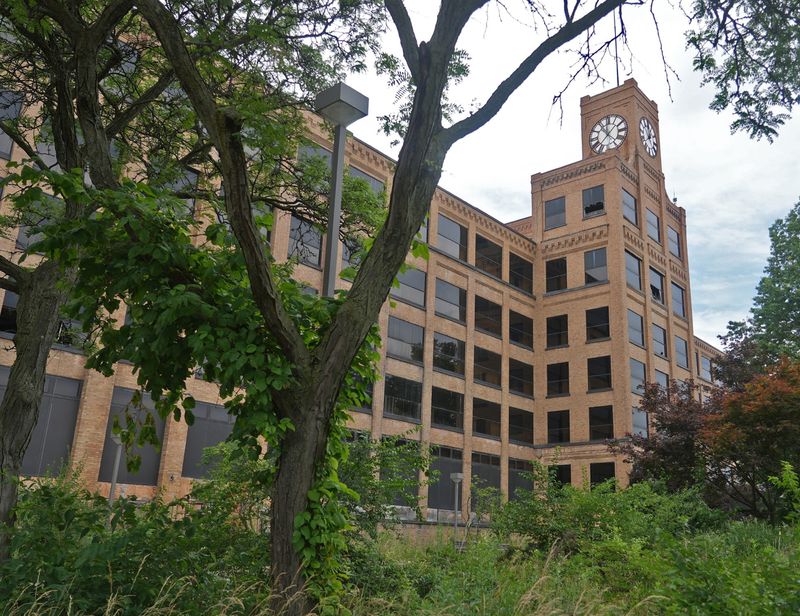The fate of a historic rubber factory and office in Akron remains in limbo.
The Akron Department of Urban Planning and Development has recommended tearing down the former Firestone Tire and Rubber Co. Plant 1 building at 1200 Firestone Parkway.

But during its July 1 meeting, the Akron Urban Design and Historic Preservation Commission decided to take more time to review the condition of the building before deciding whether to approve the demolition plans.
The commission also requests access to documents detailing the exact concerns in the building as well as photos and a potential visit to the plant.
“We are individuals that are professionals in our field, and we’d like to be able to read the information,” Commission member Leianne Heppner said. “That is my main statement − to be able to read the material. Because right now, we are making a decision on information that we don’t have. And you have the benefit of regional material, and we do not.”
City says old Firestone building is too expensive to maintain
The plant, built in 1910 as a factory and office, became an Akron Historic Landmark in 2013 and was added to the National Register of Historic Places in 2014. The preservation commission already approved the demolition of the structure’s three rear wings in June 2024 with a plan to preserve the front facade of the building.
Now, the Department of Urban Planning believes the project would be too expensive and thinks demolition is the only feasible answer.
The building is 230,400 square feet, with the iconic clock tower taking up approximately 6,300 square feet. The sheer size of the plant makes it difficult to keep secure and maintain.
The alternative to demolition would be to separate and stabilize the front bay and demolish the rear three bays. The low bid of the project is estimated to cost about $12.3 million, according to the Department of Urban Planning and Development. The low bid of the demolition is estimated to cost about $7.3 million − $5 million less than the stabilization.
The Department of Urban Planning enlisted the help of Hasenstab Architects to conduct a feasibility study for structuring what would be required to maintain the front facade of the building as well as what would be required to demolish the entire building, according to City Engineer Travis Capper.
The building hasn’t been in use for more than 10 years. Because of a covenant not to sue with the EPA, the building is prohibited from taking up any residential or daycare use. Developers have struggled to find use for the historic plant.
The Department of Urban Planning and Development has determined the building needs complete mechanical, electrical and plumbing overhaul. A full roof replacement also would be required.
“Structural analysis and probable repair are required at all damaged columns and beams,” City Planner Kurt Mulhauser said. “This all comes at a substantial cost for a vacant, 240,000 square foot building that unfortunately does not have any realistic potential for redevelopment.”
Commission can approve demolition of historic landmarks in these circumstances
The commission may a grant a certificate of appropriateness for demolition when a historic landmark meets these criteria:
Though commission received the Department of Urban Planning’s recommendation and summary of the analysis of the building’s state seven days prior, commission members − notably Elizabeth Corbin Murphy, Heppner and Mark Smith − said they need more comprehensive information to make an educated decision about the property.
Progress Through Preservation suggests saving the Firestone clock tower
Dana Noel, the advocacy chair for Progress Through Preservation, attended the meeting to speak up about potentially saving the building’s clock tower, even if the rest of the building is demolished.
Noel suggested bringing a third party architecture group that specializes in adaptive reuse of historic buildings to make the project possible.
While saving solely the clock tower could be difficult because the structure is supported by the surrounding building, Noel said a new structure potentially could be built to support it. However, City Engineer Capper said this idea would be very expensive.
Noel said he was disappointed in the lack of public input the project took in because he’s now worried there isn’t time to find an alternative solution to demolition.
“If there’s an opportunity to do anything, we all we need time to do it,” Noel said. “Whenever it’s the 11th hour, like it is now, it becomes inevitable that it gets torn down.”
Corbin Murphy said she commends the city and the commission for taking the loss of the historic building very seriously and allowing them to take time to see all possible solutions through to the end. She doesn’t want to rush this process because there is no way to bring the plant back if the commission acts too hastily.
For now, it’s up to the city to provide the commission with more materials, and many commissioners, including Corbin Murphy, want to see the plant in person before deciding. If enough information is given, the decision could be reconsidered at the commission’s August meeting.
“We have to weigh the potential for eventual redevelopment,” Akron Director of Planning Kyle Julien said, regarding the demolition. “This is our asset.”
Julien said the maintenance of the building has become a tremendous strain on the public, and his office has looked into every possible answer as to what to do with the building. At this point, he said, redeveloping the structure isn’t feasible
However, Corbin Murphy isn’t convinced the stabilization of the building would actually cost $5 million extra, and she thinks the commission needs to look closely at the details of what needs to be fixed inside the plant.
To her, the deep rooted history the building contains is the life of not only Akron, but also the entire country. She cited the factories involvement in making products for both World War 1 and 2 − particularly the women who aided the efforts during World War 2 − as just one example of the plant’s fruitful history.
The drawings of the iconic Firestone sign, which used to be on top of the building, are already in the library of congress, which Corbin Murphy thinks is an indicator of the massive influence and history the building contains.
“Not every building can be saved, but this is definitely an iconic structure,” Noel said. “It has a lot of meaning to Akron and its growth as a city, and especially during the last century. Phenomenal through the rubber industry.”
This article originally appeared on Akron Beacon Journal: ‘This has a lot of meaning to Akron’: Fate of historic Firestone building in limbo
Reporting by Julia Pentasuglio, Akron Beacon Journal / Akron Beacon Journal
USA TODAY Network via Reuters Connect


